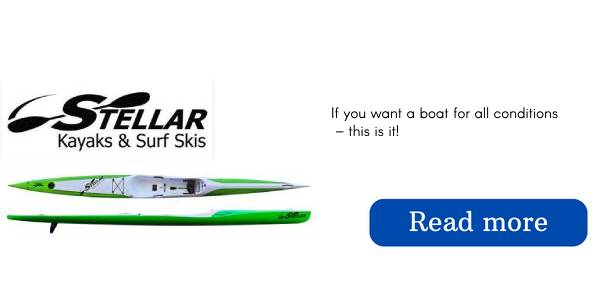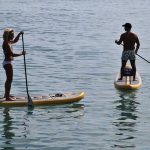But with so many different boards on the market, it can be tough to know where to start. That’s why we’ve put together this comprehensive guide to help you navigate the world of racing SUPs and find the one that’s right for you.
So whether you’re a seasoned racer or a newbie to the sport, you’ll find everything you need to know to make an informed decision and choose a racing SUP that will help you reach your full potential on the water. Let’s dive in!
sup Length
It is very important to think about size when picking a racing SUP since size affects a lot of things. A bigger board has a larger waterline, which in turn boosts its speed (bigger boards are swifter than small ones).
Boards that are larger also usually follow a straight path more easily, which can increase your speed when traveling in a straight line. Boards that are longer in length can provide a bigger wetted surface area, this can allow them to float better and thus, be better suited for people that are on the heavier side.
In contrast, shorter race boards are more agile and executing a buoy kick turn is much simpler because you don’t need to take as big a step backward (where you tend to lose balance).
SUPs that are of a smaller length workspace better in beach racing as they effortlessly maneuver through the surf.
So which board length should you choose?
14′ boards are the go-to choice for serious racers, as the most important competitions generally feature this model. If you’re serious about competing, you’ll likely want to buy a 14′ race board.
The event organiser may not bar you from using a different board category, but you would not be included in the major competition. In most races, there is an age group for 14 and Under which permits you to partake with your 12’6 or shorter board.
However, this may mean that you are sacrificing some speed. Different races might be better suited to a smaller board, like a surf race or one that has numerous turns and is relatively short in length. As a general recommendation, most paddlers should consider a 14-foot race board as their initial choice.
Boards that have no limits in terms of size and speed are not often seen and are primarily used for high-level downwind races at sea. These boards are perfect for riding downwind because their lengthy shape, approximately 18 feet, enhances their glide and enables riders to take advantage of the wind.
A rudder system is featured on the board, allowing one to direct its course without having to move around the board excessively. By doing this, there is more fun to be had when paddling in the sea and going with the wind, as it requires less effort to steer with your paddle and feet.
sup Width
A critical thing to bear in mind for those entering the world of stand-up paddle board racing is the width of the boards. The size of the board has a direct impact on the steadiness of it, and the ability to stay balanced and move through the water is essential for a successful race or practice.
Highly skilled riders may ride boards that are 21 inches or even less than 20 inches wide, however for most people, boards that are roughly 23 inches width are best for intermediate to advanced riders.
Beginners and those just starting out in SUP racing should begin with a board 24.5″ or 26″ in width before transitioning to a sleeker and faster board. It is essential to keep in mind that all surfboards have various sensations.
For example, a concave deck differs from a convex base and a pintail from a square tail. Therefore, it is a wise choice to chat to numerous people.
And, if possible, visit your local dealer to try out the board beforehand. Always remember stability is more important than speed. It is impossible to move quickly while swimming in water.
Planing vs Displacement Hull
When looking at what race board to acquire, two major hull categories to take into consideration are planing and displacement. The major contrast between a planing hull and a displacement hull on a paddleboard is how the board propels itself through the liquid.
A displacement hull has a curved or multiple curved bottom structure. One of the chief advantages of owning a concave skateboard is it is able to be smaller in size whilst still maintaining stability and speed, due to its extra surface area.
This design does not rapidly skim across the surface of the water like a planing hull; instead, it pushes through and divides the water.
Stand-up paddleboards that have a displacement hull shape will have a front end which is pointed to aid the board in cutting into the water, increasing the amount of hull that is in contact with the water.
The hull of the SUP cuts through the water, directing the liquid aside of the bow, which increases the speed and produces a tranquil glide. A displacement hull takes less effort to paddle than a planing hull, meaning you can cover larger distances more quickly.
They tend to move in a straight line well, however usually they are less maneuverable when compared to planing hulls.
Typically you would select a displacement hull stand up paddleboard for competing on flat water and extensive course contests.
A planing hull has a bottom surface that is either flat or has a convex Vee shape. Planing hulls are created to rapidly move along the top of the water, basically, the board will nearly glide above the waterline.
This also makes them very manoeuvrable. In order to accomplish their goal, they usually have a very thin tail. You need to bear in mind that with a rounded bottom board, you cannot create a displacement hull that is as slim as it can be.
Boards with a curved underside are an ideal option for cruising along or over waves in the sea or in rough waters, as well as for technical competition sailing where agility is paramount.
These boards are usually suitable for a variety of environments.
Board Features
When selecting a race board, there are a few key aspects to consider, like the handles (and their locations), the leash attachments, a deck mat, a tail kick pad, and FCS placements for GPS.
Having a comfortable grip on the race handle is one of the most important components. Some people who ride enjoy having rein aids, either two sets on the sides of their horse or one looped rein, while others feel content utilizing just the central grip.
Leashes are important for flat water racers, who typically have it attached in front of them. In ocean races, surf racers, and sprint racers, the leash is usually connected at the back.
An essential element for control and traction when making turns is the deck pad and should not be disregarded. When competing in a race, you may need to make a fast turn in order to get into a better position, or else have enough traction and ease to grab a wave and ride it all the way to shore.
A race board should have a tail kick pad, like what you would see on a regular surfboard, for optimum performance. The more coarsely grained pad and the concluding ‘kick’ are significant aids that enable a racer to figure out where the back of the board is without having to avert their gaze or turn around and center their attention on the event.
It is effortless to go too far beyond the tail of the board when wave riding or completing a buoy turn without someone looking out.
You may want to consider purchasing mounts for GoPros or GPS watches, which can provide you with a way to keep track of your activity, as well as let you take selfies with your friends.
Tips for Paddleboard Racing
Paddle boarding can be undertaken as a leisurely activity, as a serious contest, or even for rewards. Generally speaking, it’s not encouraged to try this activity soon after learning how to paddle board.
If you are simply looking for an excuse to spend time with people who already enjoy running races, it’s okay to take part in a race purely for enjoyable reasons and not worry about how you do.
1. Practice, Practice, Practice
Have you heard of the 10,000-hour rule? It is claimed that if you persistently practice racing your paddle board for 10,000 hours, then you could become an expert in the field.
Research in the scientific field has substantially demonstrated that it is not correct to believe that one needs to devote 417 days to be an expert paddleboard racer – thus it is not necessary to take on that endeavor.
That said, there’s no substitute for practice. Throughout this guide, we will be discussing the importance of practicing in different kinds of weather. You should gradually extend the amount of time you spend on the bike and how far you go.
We can talk about increasing your speed at a later date.
2. Train on your paddle board with others
You enjoy SUP boarding, but you need the drive to go out there and perform to the best of your ability.
Here’s where group riding can be quite useful. If you and some of your other paddleboarders make a promise to support one another when someone is feeling low, then you will likely have fewer skipped practice times.
When you engage in SUP practice as part of a group, you get a sense of responsibility as well as many other advantages. By watching them, you can discover new methods for rowing and paddling which you may have never known before. Further, your pals can help you improve your form.
It’s hard to observe your own form, so if you’ve adopted a stance that’s less than ideal, your mates will be the first to spot it and aid you with bettering it. You will be in an improved position to start preparing for your initial SUP race.
3. Master the paddle board basics first
You need to be completely familiar with the fundamentals of the subject, inside and out. As you compete, you will pay close attention to your breathing, getting enough fluids, increasing your speed, and preserving it.
If it takes too much effort and time to recall how to paddle correctly, it won’t help you win the competition.
Besides the basics like standing on your board, balancing, and holding your paddle, here are some other techniques to familiarize yourself with:
- Drafting: When you draft on your paddleboard, you kind of follow the momentum generated by the racer in front of you. This allows you to use less of your own energy, as the force of that momentum can keep you going for a while. When you feel recovered enough, you can then get back into the race. NOTE: Drafting is not always allowed during SUP racing. Don’t do it if it’s discouraged or you could end up disqualified for your efforts!
- Pivot turns: To move yourself past a buoy or marker, it pays to know how to do a pivot turn. You want to keep your feet towards the back of the paddleboard near its tail. Then put one foot in front of the other and position your paddle so it’s in the middle of your board. Next, turn yourself in a circular motion, which should be done sharply.
- Strokes: We’ve written about how to do strokes on your board before, but one thing we haven’t talked about is how racers think when doing this. They divide their stroking into various parts, typically four. These are reach, catch, power, and recovery. If you think of stroking like this, you can do it more efficiently during your races.
4. Get Your Body in the Best Shape Possible
Though it is possible to firm and form your physique by Stand Up Paddleboarding, as was mentioned previously, you can’t be on your board continuously.
It’s simply not healthy for you. Take a break from the pool and commit to physical activity elsewhere, such as at a health club or even in your own house with the required gear.
A lot of people who stand-up paddle board recommend working out in a variety of ways to help stay fit, utilizing an array of exercises to target different muscles.
Doing cross-training combines elements from different sports which you may enjoy, for example running, yoga, swimming, mountain biking, and more.
5. Choose the right board and paddle
You should ensure that the board you utilize is the one you like the most. You don’t have to stick with the same board if it’s preventing you from completing the task quickly, but you should pick one that is suited to you.
It is essential to take into account various aspects while deciding on which paddle board is best for you. You can choose the ease of having an inflatable board should it be allowed in the competition.
You have the option of picking an inflexible SUP board manufactured with substances such as plastic, carbon fiber, or EPS foam that has an epoxy and fibreglass interior. Each of these materials has advantages over others.
An example of this is that plastic paddleboards are reasonably priced, but due to the lower cost, they have considerably more weight and don’t provide good performance. Carbon fibre boards cost more and are more rigid than plastic, yet they are lighter.
You will have to choose between a displacement or a planing hull type for your surfboard.
in conclusion
And that’s it, folks! We hope this guide has given you a better understanding of what to look for in a racing SUP. Whether you’re a seasoned pro or a newbie to the sport, finding the right board can make all the difference in your performance and overall enjoyment.
By considering factors like board length, width, and shape, you can find a racing SUP that suits your skill level and paddling style. And let’s not forget about additional features like durability, stability, and weight – all of which can impact your speed and maneuverability on the water.
So if you’re ready to take your racing game to the next level, be sure to do your research and choose a board that meets your specific needs. With so many great options out there, you’re sure to find a racing SUP that makes you feel like a champion on the water.
Now, get out there and start shredding those waves like a pro. Happy paddling!




